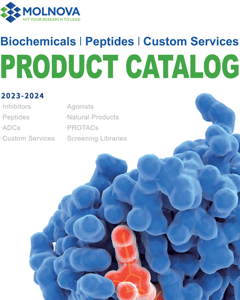
Proteinase
CAS No. 9001-92-7
Proteinase( —— )
Catalog No. M33618 CAS No. 9001-92-7
Proteinases are enzymes that catalyse the breakdown of proteins. Proteinases are involved in many biological functions, including the digestion of ingested proteins, the breakdown of old proteins, and cell signalling.
Purity : >98% (HPLC)
 COA
COA
 Datasheet
Datasheet
 HNMR
HNMR
 HPLC
HPLC
 MSDS
MSDS
 Handing Instructions
Handing Instructions
| Size | Price / USD | Stock | Quantity |
| 500MG | 35 | In Stock |


|
| 1G | 42 | In Stock |


|
Biological Information
-
Product NameProteinase
-
NoteResearch use only, not for human use.
-
Brief DescriptionProteinases are enzymes that catalyse the breakdown of proteins. Proteinases are involved in many biological functions, including the digestion of ingested proteins, the breakdown of old proteins, and cell signalling.
-
DescriptionProteinase (EC 3.4.24.33) refers to the enzymes with proteolytic activity.
-
In Vitro——
-
In Vivo——
-
Synonyms——
-
PathwayOthers
-
TargetOther Targets
-
RecptorOthers
-
Research Area——
-
Indication——
Chemical Information
-
CAS Number9001-92-7
-
Formula Weight
-
Molecular Formula——
-
Purity>98% (HPLC)
-
SolubilityIn Vitro:?H2O : 50 mg/mL (Ultrasonic)DMSO : 20 mg/mL (Ultrasonic )
-
SMILES——
-
Chemical Name——
Shipping & Storage Information
-
Storage(-20℃)
-
ShippingWith Ice Pack
-
Stability≥ 2 years
Reference
molnova catalog



related products
-
Acetic acid, 2-[4-[(...
Acetic acid, 2-[4-[(2-ethyl-3-benzofuranyl)carbonyl]phenoxy]- is a compound used for antiviral activity determinations.
-
Argipressin acetate ...
Vasopressin acetate is a peptide hormone with vasoconstrictive and antidiuretic activities that binds to the vascular arginine vasopressin receptor, V1, with Kd values of 1.31 and 1.44 nM in A7r5 rat aortic smooth muscle cells and neonatal rat cardiomyocytes, respectively
-
Gadodiamide b
Gadodiamide is an MRI contrast agent used in MR imaging procedures to assist in the visualization of blood vessels.



 Cart
Cart
 sales@molnova.com
sales@molnova.com


